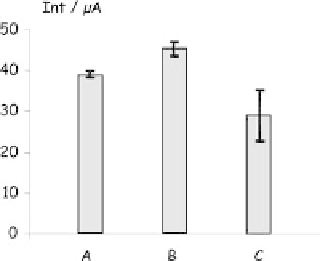Biology Reference
In-Depth Information
Figure 9.15.
Analytical signals obtained for 50 pM of biotinylated target,
using a genosensor fresh prepared (A), a genosensor in which thiolated
probeswereimmobilizedandstoredat4
◦
Covernight(B),andagenosensor
stored at 4
◦
C where both, probe and blocking agent were immobilized.
Reproduced with permission from Wiley InterScience [11].
stored at 4
◦
C. With this aim, SPCnAuEs were modified following the
procedure previously described andstored at 4
◦
C overnight.
Results obtained are displayed in Fig. 9.15, and show that the
analytical signal due to a biotinylated target concentration of 50 pM
results incremented in about 15%. However, when the blocking
step is also carried out prior to the storage of the sensing phase,
the analytical signal due to the same concentration of biotinylated
target gives rise to a decrease of about 20% of the analytical
signal.
With SPCnAuEs modified with the probe strand and stored at
4
◦
C overnight, a calibration plot was recorded. A linear relationship
of the analytical signal with the concentration of the biotinylated
target strand in the range comprised between 2.5 and 50 pM
was obtained. The detection limit, calculated as the concentration
corresponding to a signal that is three times the standard deviation
of the intercept, was found to be 2.5 pM. The linear range obtained
withthismethodologyiscloserthanthatobtainedwhenthesensing
phase is freshly prepared, but its sensibility is around three times
thatobtainedwiththeformermethodology.Moreover,storageofthe
sensing phase permits to minimize the analysis time and increases
the possibility of storing the genosensors and using them when
necessary.









